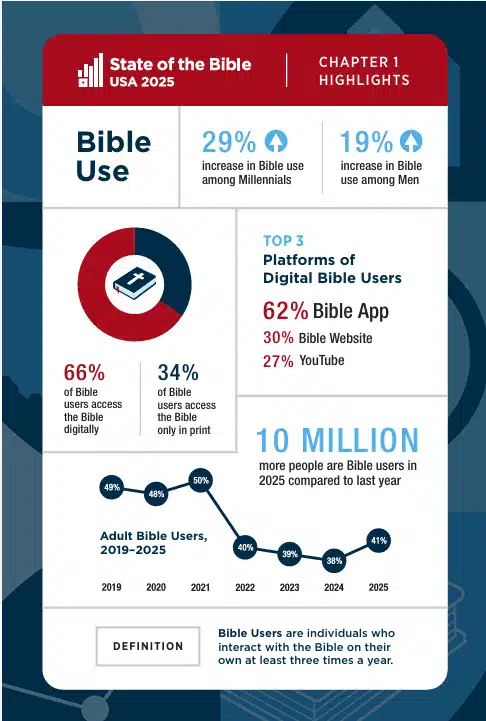An estimated 10 million more adults qualified as Bible users in January 2025 than in 2019, the American Bible Society said in its new State of the Bible release, but usage still lags behind pre-COVID-19 readership by 14 million adults.
While the ABS has an admittedly low bar for Bible usage — three times a year outside of organized church worship — at least a quarter of U.S. adults turn to the Bible on their own weekly or more frequently.
“For the first time since 2021, we’re seeing an increase in both Bible use and Scripture engagement, particularly among younger adults and in men,” John Farquhar Plake, ABS chief innovation officer and State of the Bible series chief editor, said April 10 in releasing the findings. “People are curious about the Bible and Jesus.”
 Specifically, 41 percent of adults, or 110 million, ranked as Bible users by ABS standards, up from 38 percent, or 99 million, last year, researchers said. The numbers compare to pre-pandemic levels of 49 percent, or 124 million, in 2019, and a high of 50 percent, or 128 million, in 2021.
Specifically, 41 percent of adults, or 110 million, ranked as Bible users by ABS standards, up from 38 percent, or 99 million, last year, researchers said. The numbers compare to pre-pandemic levels of 49 percent, or 124 million, in 2019, and a high of 50 percent, or 128 million, in 2021.
Scripture engagement, a more robust category that measures the centrality of the Bible in people’s decision-making and how it impacts their relationships, increased to 20 percent in January from 18 percent the previous year. But it lagged behind the 25 percent in 2019. In 2025, a majority of U.S. adults, 54 percent, were decidedly Scripture-disengaged, compared to a minority of 47 percent in 2019. Others were in a category described as the movable middle, those open to the Bible as a source of spiritual wisdom.
“Together (the Church) must respond with creativity and innovation,” Plake said. “Opportunities like this don’t come along every day, so we need to listen carefully and respond to our neighbors with grace, hope and truth.”
While Boomers utilized the Bible more frequently in 2024 and 2025, at 45 percent and 46 percent respectively, Millennials led the way in progress, with usage rising to 39 percent in 2025 from 30 percent the previous year.
Still, Millennials remain the least Scripture-engaged at 17 percent, a metric that increased this year from the 2024 level of 12 percent.
Researchers offered no reasons for the increases, but noted a cultural attraction to creative media featuring the lives of people featured in Scripture, such as “The Chosen.”
“Can we credit a particular TV show or ad campaign with these increases? Our research does not directly address motivations, but it is clear that people are looking for answers … increasingly in visual media,” researchers wrote. “These sorts of public presentations reinforce the quietly faithful lives and creative outreach of millions of Christians eager to share with their neighbors the ‘greatest story ever told.’”
In its 15th year, the State of the Bible expands its resources this year to include with each chapter the State of the Bible Podcast, a series of short videos offering insights from research findings, and a toolkit for church leaders.
Research findings are gleaned from a nationally representative survey performed for ABS by NORC at the University of Chicago, using their AmeriSpeak panel. The data came from 2,656 online interviews conducted Jan. 2-21 with American adults in all 50 states and the District of Columbia.
Among other key findings:
- Millennial men increased Bible usage in the study year, rising from 32 percent to 40 percent.
- While the South leads in Bible usage at 48 percent compared to 47 percent the previous year; its lead is shrinking as other regions see larger increases: West, at 39 percent from previous 33 percent; Midwest, up 39 percent from 34 percent; and Northeast, rising 33 percent from 28 percent.
- By ethnicity, black people continue to lead in Bible usage at 68 percent (up from 61 percent), followed by Hispanics, 41 percent (down from 42 percent); whites, 37 percent (up from 33 percent); and Asians, 38 percent (up from 22 percent).
- Evangelical Protestants and historically black Protestants led in Bible usage at 73 percent and 72 percent, respectively.
- More than half of U.S. adults, 51 percent, said they wish they read the Bible more.
- A third of Bible users access the Bible only in print, while two-thirds of readers use digital versions at least some of the time. Of digital users, 62 percent use Bible apps.
Other 2025 State of the Bible chapters, released monthly, will address Bible views and usage globally, human flourishing, faith and trust, engagement with the church, Gen Z’s search for identity, Bible engagement and self-care, how loving God impacts loving neighbors, and love in action.
The first chapter of the 2025 edition is available here.
— Diana Chandler is Baptist Press’ senior writer.
